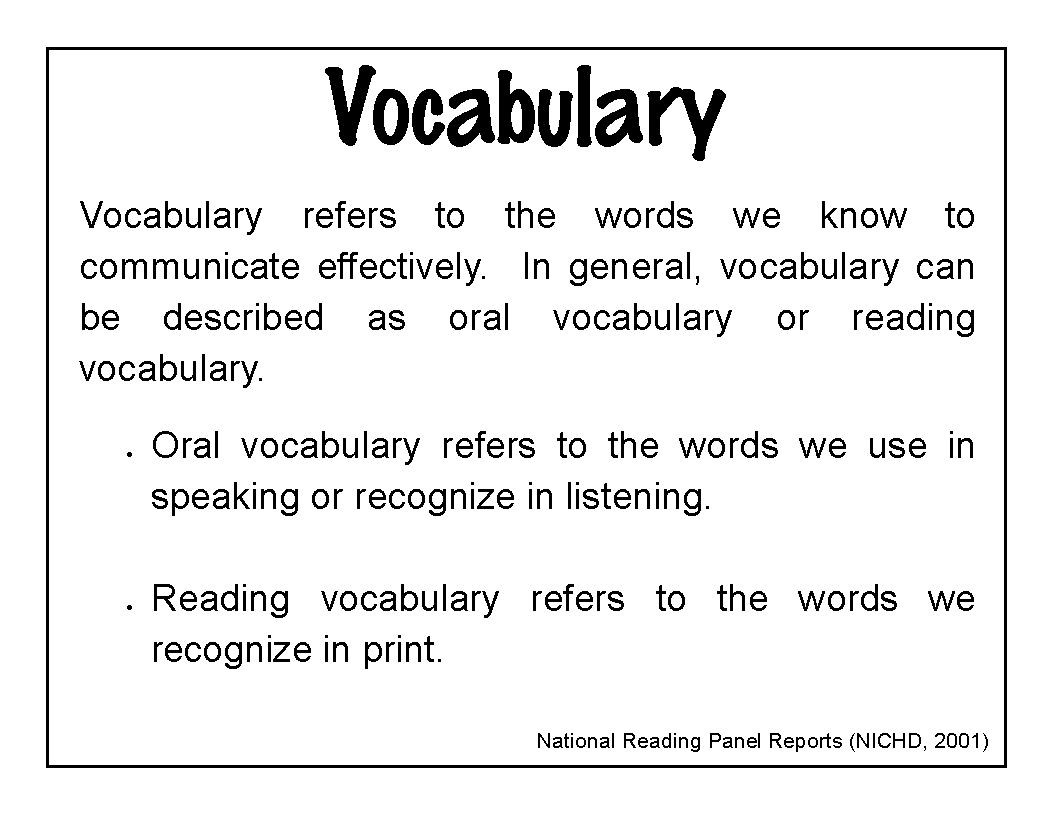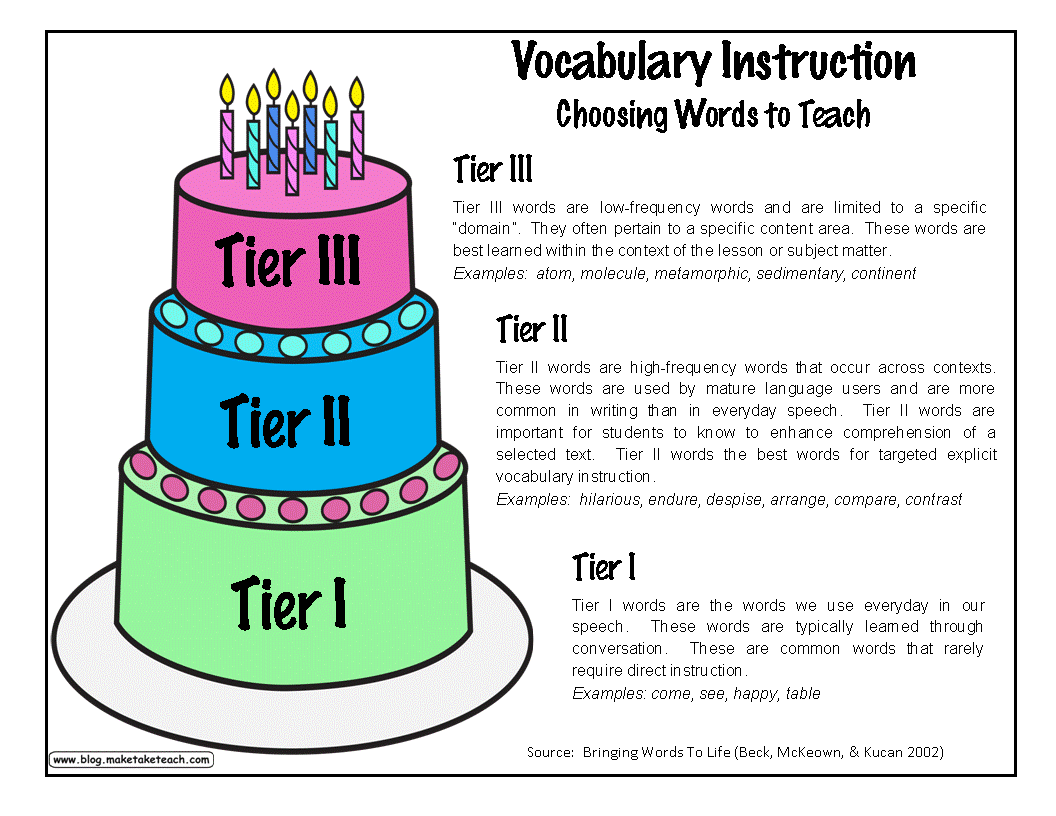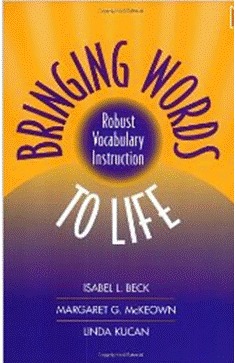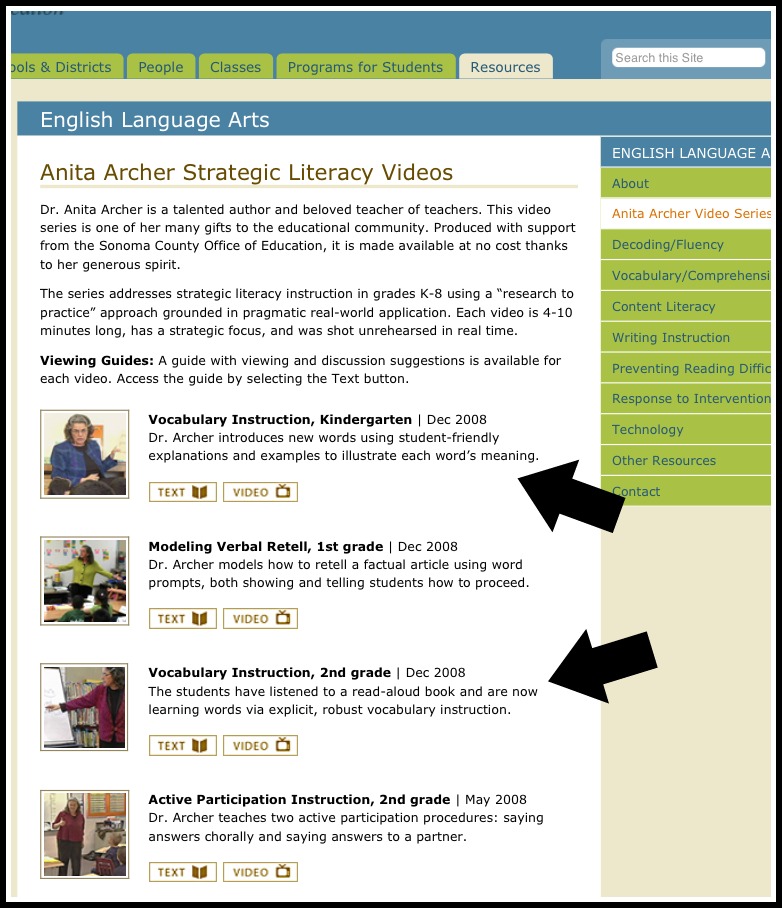This year we are working on expanding our RtI efforts to upper elementary. Reading First so nicely laid out the expectations for quality core instruction for K-3, but we are finding that we are having to dig a little deeper into the research to find what effective literacy instruction looks like at the upper elementary level. Explict vocabulary instruction and reading comprehension strategies are recurring themes in our reading. Although very important in K-3 instruction, vocabulary and reading comprehension take center stage in upper elementary. So with this in mind, I pulled out my favorite vocabulary resource book, Bringing Words to Life, along with other resources on vocabulary, to help guide us.
What is vocabulary?
The following is the National Reading Panel’s definition of vocabulary. It’s important to make the distiction between oral vocabulary and reading vocabulary. Oral vocabulary can be further divided into listening vocabulary (receptive vocabulary, as our SLP’s call it) and speaking vocabulary (expressive vocabulary). The words that are encountered in text (reading vocabulary) are more complex than our speaking vocabulary.
Click the following link to download this definition Vocabulary Definition
Why is vocabulary important?
Vocabulary is important because it is a strong predictor of reading comprehension. If children are to understand the text, they must know what most of the words mean before they can comprehend what they are reading. Of course, this makes sense! Children with well developed vocabularies can recognize a new word in text faster and easier if the word has an identity in their mind. Let’s consider the following example from The Mitten:
“A waft of warm steam rose in the air, and a fox trotting by stopped to investigate. Just the sight of the cozy mitten made him feel drowsy.”
These two sentences are loaded with vocabulary (so cool!). What if the underlined words were not a part of the child’s vocabulary and he has never been exposed to those words in conversation or having books read to him? Certainly the child’s understanding of the text would be affected and when the child tried to read those words, he would not have the background knowledge that would help him figure out the word. Even if a child knew 4 of the 5 words, he would likely have an understanding of the text.
Choosing Words To Teach
So, if building vocabulary is so important, and with so many words, how do you choose which words to teach directly? Isabel Beck and her colleagues have developed a really nice framework for choosing the most important words that should be targeted for instruction. She divides words into three “tiers”. In a nutshell, Tier I words are the most common words, Tier II words are high-frequency words used by mature language users, and Tier III words are typically specialized words. She recommends identifying and teaching Tier II words as they occur and can be used across contexts.
Click the following link to download the graphic Vocabulary Instruction- Choosing Words to Teach
With young children, the vocabulary words are typically chosen from trade books; these are the books that teachers read aloud to their students. Choosing words from a text for direct teaching is not difficult, but there are some things you need to take into consideration. These considerations as well as examples are provided in the Bringing Words To Life book. I can’t say enough about this book. If you want to beef-up your vocabulary instruction, this is a must-read.
How Many Words do Children Need to Know?
Researchers say that children in grades 1-2 need to learn 800 new words a year (that’s 2 a day) and children from 3rd grade on need to learn 2,000-3,000 new words a year (6-8 words a day)(Diemiller; Nagy & Anderson). On top of that, consider that for a child to “truly” know a word he/she must have at least 10-12 exposures to the word in multiple contexts. Sounds daunting, doesn’t it? Now consider this. Researchers (Biemiller, 2001) noted that there is very little explicit vocabulary teaching occurring in the upper grades. In fact, one study revealed that upper-elementary teachers spent less than 1% of their overall reading instruction focused on vocabulary. Yikes!
How to Teach Vocabulary
Children learn words in a variety of ways. One of the best ways to improve vocabulary is through wide reading. One interesting study that I found reported that the average 5th grader reads 5 minutes a day out of school. 5th graders who fall at the 80th percentile read over 20 times as much students who fall at the 20th percentile who read only one minute outside of school. Although reading in and of itself is necessary for vocabulary growth, it is not sufficient. Students need direct and explicit vocabulary instruction. So what does that look like and what is the best way to teach vocabulary? Well, that’s going to the topic of upcoming blog posts (too long already). I do want to leave you with these videos that model explict vocabulary instruction. Sometimes it’s just easier to see it in practice than explain in words.
Anita Archer is a highly respected author and educator. The Sonoma County Office of Education has on their website a series of videos of Anitia Archer demonstrating specific teaching strategies. When you click the following link (the picture), you can see her teaching a vocabulary lesson to a kindergarten class and then to a second grade class.
Thanks for sticking with me on the quite long blog post. Hope this has been helpful in understanding the importance of direct vocabulary instruction.





Leave a Reply